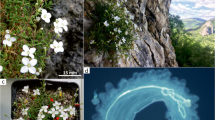Summary
A multilocus mixed mating model was used to analyze the mating systems of two tropical canopy trees in the Bombacaceae that differ in successional status and overall abundance. One population of each species was studied on Barro Colorado Island, Republic of Panama. Population outcrossing estimates of 0.57 and 0.35 from two years indicate a mixed-mating system with intermediate outcrossing levels for the gap-specialist Cavanillesia platanifolia, a relatively rare component of the island flora. Population and individual outcrossing estimates were associated with flowering tree density or degree of spatial isolation. Trees within clusters of flowering individuals have a higher degree of outcrossing than isolated trees. Annual estimates of individual tree outcrossing rates varied greatly as a function of flowering in its nearest neighbors. In contrast to C. platanifolia, Quararibea asterolepis was completely outcrossed and may be self incompatible. Maternal trees of both species had significantly heterogeneous pollen pools indicating non-random outcrossing. Apomixis by sporophytic agamospermy was rejected in C. platanifolia as contributing to the apparent selfing rate.
Similar content being viewed by others
References
Ashton PS (1977) A contribution of rain forest research to evolutionary theory. Ann Missouri Bot Gard 64:694–705
Augspurger CK (1984a) Light requirements of neotropical tree seedlings: a comparative study of growth and survival. J Ecol 72:777–795
Augspurger CK (1984b) Seedling survival among tropical tree species: interactions of dispersal distance, light gaps, and pathogens. Ecology 65:1705–1712
Baker HG (1959) Reproductive methods as factors in speciation in flowering plants. Cold Spring Harbor Symp Quant Biol 24:177–199
Baker HG, Baker I (1968) Chromosome numbers in the Bombacaceae. Bot Gaz 129:294–296
Bawa KS (1974) Breeding systems of tree species of a lowland tropical community. Evolution 28:85–92
Bawa KS (1979) Breeding systems of trees in a tropical wet forest. New Zealand J Bot 17:521–524
Bawa KS, Perry DR, Beach JH (1985) Reproductive biology of tropical lowland rain forest trees. I. Sexual systems and incompatibility mechanisms. Am J Bot 72:331–345
Brown AHD (1979) Enzyme polymorphisms in plant populations. Theor Pop Biol 15:1–42
Brown AHD, Allard RW (1970) Estimation of the mating system in open-pollinated maize populations using isozyme polymorphisms. Genetics 66:133–145
Clegg MT (1980) Measuring plant mating systems. Bioscience 30:814–818
Croat TB (1978) Flora of Barro Colorado Island. Stanford University Press, Stanford, CA
Ellstrand NC, Torres AM, Levin DA (1978) Density and the rate of apparent outcrossing in Helianthus annuus (Asteraceae). Syst Bot 3:403–407
Federov AA (1966) The structure of the tropical rain forest and speciation in the humid tropics. J Ecol 54:1–11
Fripp YJ, Griffin AR, Moran GF (1987) Variation in allele frequencies in the outcross pollen pool of Eucalyptus regnans F. Muell. throughout a flowering season. Heredity 59:161–171
Garwood NC (1985) The role of mucilage in the germination of Cuipo, Cavanillesia platanifolia (H. & B.) H.B.K. (Bombacaceae), a tropical tree. Am J Bot 72:1095–1105
Glover DE, Barrett SCH (1986) Variation in the mating system of Eichornia paniculata (Spreng.) Solms. (Pontederiaceae). Evolution 40:1122–1131
Hamrick JL, Godt MJ (1989) Allozyme diversity in plants. In: Brown AHD, Clegg MT, Kahler AL, Weirs BS (eds) Population genetics and germplasm resources in crop improvement. Sinauer, pp 43–63
Hamrick JL, Linhart YB, Mitton JB (1979) Relationships between life history characteristics and electrophoretically detectable genetic variation in plants. Ann Rev Ecol Syst 10:173–200
Hartshorn GS (1978) Treefalls and tropical forest dynamics. In: Tomlinson PB, Zimmerman MW (eds) Tropical trees as living systems. Cambridge University Press, Cambridge, pp 617–638
Hladik A, Hladik CM (1969) Rapports trophiques entre vegetation et primates dans la floret de Barro Colorado (Panama). La Terre et la Vie 1:25–117
Hubbell SP, Foster RB (1990) Structure, dynamics, and equilibrium status of old-growth forest on Barro Colorado Island. In: Gentry AH (ed) Four neotropical forests. Yale University Press, New Haven, CT (in press)
Kaur A, Ha CD, Jong K, Sands VE, Chan HT, Soepadmo E, Ashton PS (1978) Apomixis may be widespread among trees of the climax rain forest. Nature 271:440–441
Lamb FB (1953) The forests of Darien, Panama. Caribbean Forest 14:128–135
Loveless MD, Hamrick JL (1987) Distribución de la variación en especies de árboles tropicales. Rev Biol Trop 35 [S 1]:165–175
Mitton JB, Linhart YB, Sturgeon KB, Hamrick JL (1979) Allozyme polymorphisms detected in mature needle tissue of ponderosa pine. J Heredity 70:86–89
O'Malley DM, Bawa KS (1987) Mating system of a tropical rain forest tree species. Am J Bot 74:1143–1149
Richards AJ (1986) Plant Breeding Systems. Allen and Unwin Press, London, UK
Ritland K, Jain SK (1981) A model for the estimation of outcrossing rate and gene frequencies based on n independent loci. Heredity 47:37–54
Schemske DW, Lande R (1985) The evolution of self-fertilization and inbreeding depression in plants. II. Empirical observations. Evolution 39:41–52
Soltis DE, Haufler CH, Darrow DC, Gastony GJ (1983) Starch gel electrophoresis of ferns: a compilation of grinding buffers, gel and electrode buffers, and staining schedules. Am Fern J 73:9–15
Stebbins GL (1957) Self fertilization and population variability in higher plants. Am Nat 91:337–354
Sun M, Ganders FR (1988) Mixed mating systems in Hawaiian Bidens (Asteraceae). Evolution 42:516–527
Tisserat B, Esan EB, Murashige T (1979) Somatic embryogenesis by Angiosperms. Hort Rev 1:1–78
Vasek FC, Harding J (1976) Outcrossing and natural populations. V. Analysis of outcrossing, inbreeding, and selection in Clarkia exilis and Clarkia trembloriensis. Evolution 30:403–411
Zapata TR, Arroyo MTK (1978) Plant reproductive ecology of a secondary deciduous tropical forest in Venezuela. Biotropica 10:221–230
Author information
Authors and Affiliations
Rights and permissions
About this article
Cite this article
Murawski, D.A., Hamrick, J.L., Hubbell, S.P. et al. Mating systems of two Bombacaceous trees of a neotropical moist forest. Oecologia 82, 501–506 (1990). https://doi.org/10.1007/BF00319793
Received:
Accepted:
Issue Date:
DOI: https://doi.org/10.1007/BF00319793




